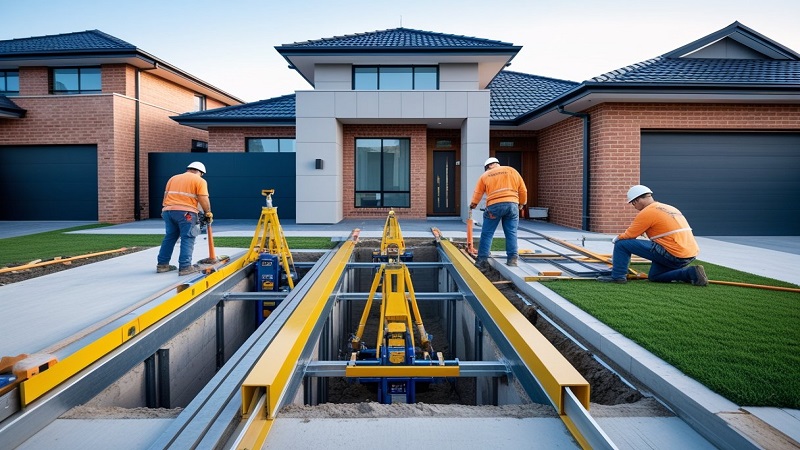Uneven floors, cracks in walls, and sticking doors are often signs that your home may be out of level. These issues can arise when stumps under your house deteriorate or shift over time. This article outlines how house levelling works, the typical timelines involved, and what Melbourne homeowners should expect. We’ve consulted Josef Shun from Truss Reblocking & Underpinning for expert advice.
What Is House Levelling?
House levelling is the process of correcting the foundation of a home so that the floors are horizontal again. It typically involves lifting the structure and replacing or adjusting the stumps that support it.
Timber stumps, common in older Melbourne homes, are prone to decay, termite damage, or soil movement. As these stumps deteriorate, the house may begin to tilt or sag. Levelling addresses these issues by installing new stumps and realigning the building.
Josef from Truss Reblocking & Underpinning says, “Many homes across Melbourne still sit on ageing timber stumps. Replacing these before they fail completely can save homeowners a lot of hassle and expense.”
How Long Does House Levelling Take?
The time it takes to level a house in Melbourne ranges from 1 to 10 days, depending on the scope of work.
Here’s a breakdown:
- Partial levelling (15–30 stumps): 1 to 3 days
- Full house levelling (50–100+ stumps): 5 to 10 days
- Permit delays, inspections, and weather may extend the total timeframe
Tight access under the house and structural repairs can also affect the schedule. Josef adds, “Timelines always vary. Sometimes a job we plan for five days turns into eight because we uncover extra damage like bearers and joists that need replacing.”
Steps Involved in Levelling a House
There are 4 main stages in the house levelling process:
- Assessment and Planning
A site inspection is carried out to identify which stumps need replacement and to assess the condition of the structure. Engineers or building surveyors may be involved. - Lifting the Structure
Hydraulic jacks are used to lift the home gradually and safely, giving workers space to remove and replace stumps. - Replacing Stumps
Old stumps are removed and replaced with concrete or galvanised steel. These new stumps are carefully adjusted to restore floor levels. - Final Checks and Clean-up
Once the structure is back in place, everything is rechecked to confirm level alignment, and debris is removed.
Josef explains, “Precision is critical. If one stump is slightly off, it can throw out the entire floor line. This is even more critical in older homes where extensions have shifted independently over the years.”
Common Signs You May Need House Levelling
There are 5 signs that your home needs house levelling:
- Floors sloping or feeling uneven underfoot
- Cracks forming in plaster walls or ceilings
- Doors and windows jamming or misaligning
- Skirting boards pulling away from floors
- Visible stumps looking sunken, cracked, or rotted
These indicators are often gradual. Homeowners might ignore them until one issue leads to another. Josef notes, “If you’re seeing more than one of these signs at once, it’s time to act. The longer you wait, the more complicated the job becomes.”
Do Melbourne Homes Face Special Levelling Challenges?
Melbourne’s clay-heavy soil is a key factor. It expands in wet seasons and contracts in dry conditions, putting pressure on stumps. Homes in suburbs with tight access — like Carlton or St Kilda — may also need access dug below the house, slowing things down.
Most local councils require permits or engineering for stump replacement, especially in heritage areas. These regulations can affect start dates and total duration.
“Each area comes with its own quirks,” says Josef. “In some cases, we’re not just dealing with stumps but also dodgy past renovations or uneven add-ons that need levelling too.”
Why Hire Professionals for House Levelling?
Professional house levelling teams bring experience, equipment, and compliance with regulations. Key advantages include:
- Safety – Structural lifting done with controlled force
- Efficiency – Projects finished faster with fewer disruptions
- Quality control – Proper re-levelling that lasts
- Warranty – Professional work is often covered
Josef stresses, “Cutting corners on foundation work can cause bigger problems down the track. We’ve fixed plenty of DIY jobs gone wrong.”
Final Thoughts for Melbourne Homeowners
House levelling is essential for homes showing signs of foundation movement. While timelines vary from a couple of days to over a week, early detection and action can prevent more serious damage.
If you live in Melbourne and notice sloping floors or cracked walls, it’s time to speak with a professional. Truss Reblocking & Underpinning offers experienced advice, thorough assessments, and tailored solutions to help keep your home solid and safe.
